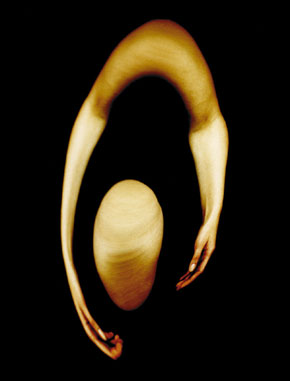|
|
|
 |
 |
|
Sculpturesque Photography of Tomasz Komorowski
Tomasz Komorowski's talent exploded at the end of the 1990s. I use the verb "to explode" because Komorowski appeared out of nowhere with extraordinarily mature photographs of deformed, naked female bodies of surrealistic visual qualities which, in his case, have not changed much over the years. Which is a rare phenomenon. And Komorowski's talent has been and still is developing fast. What is the origin of these colour photographs, most often copied in large formats? It is not easy to answer this simple question. Undoubtedly the artist had had to wait long to unveil his photographic experiments with the female body, but his works were quickly appreciated, as many prestigious individual and group exhibitions prove.
Tomasz Komorowski consciously uses the method employed in the famous series of nudes called "Distortion" by a Hungarian photographer, André Kertész, who worked at that time in the circles of Parisian modernism. He was under the influence of surrealism and abstraction, as well as particular heroes of modernity, including Pablo Picasso. But the effect of the Polish artist's photographs is completely different. He realizes that his pictures are an independent form of photography and that depending on their visual character they follow and at the same time probe new solutions: a) sculpturesque, b) pictorial, c) filmic. However, one should note that however clear his inspirations may be, Komorowski's art is original. He consciously exposes the qualities of the medium showing details of the model's skin, as well as particular, fragmented elements of her body in the search for symbolic forms, related to a different spiritual space. One thing that all his photographs have in common is their specific colour. Unreal, yellowish bodies are always presented against a black background. In this way specific pictorial qualities are brought to the surface. Analyzing the formal solutions I have mentioned I shall try to point out the differences between them. a) The artist correctly believes his most important works to be abstract in form, but also expressionistic, in which they resemble the sculptures of Hans Arp, Constantin Brancusi, Henry Moore and Alberto Giacometti. In his transient, changeable and glimmering message Tomasz Komorowski is looking for a "frozen" and paradoxically stable photographic form. His art includes elements of performance in front of a photographic camera, which Leszek Golec and Tomasz Michałowski practised, among other artists, in Poland at the beginning of the 90s. By means of deformation a hand, an arm or a head become, in effect, unreal and alienated. One of Komorowski's photographs resembles the famous paleolithic sculpture called "Venus of Willendorf", but in his case, thanks to the symmetrical structure and the clarity of the whole figure, the work is quite original. Let us remember that his works are purposefully stripped of any gender traits, which is all the more unusual since photography of the 80s and 90s in Poland and elsewhere was in this respect definitely more perverse and seditious, transgressing and broadening the limits of the so-called good taste and the notion of pornography (Robert Mapplethorpe, Andres Serrano). b) Generally speaking, Tomasz Komorowski was certainly inspired by the paintings of Zdzisław Beksiński which are decidedly more manneristic and marked by decorativeness, pathos and very often kitsch, insignificant as far as the author is concerned. Contrary to Beksiński's paintings, photographs by Tomasz Komorowski, sparing in form and monochromatic in colour, do not contain elements of kitsch. The author is looking for totemic, symbolic forms, photographying uncommon, symmetrical hand structures. c) Visions presented in Komorowski's pictures may be associated with nightmares and hallucinations. Naturally it is a surrealistic trope, but, photographic origins notwithstanding, it may also possess filmic inclinations. Ridley Scott's movie, "Alien", was admired all over the world in the 80s, as well as James Cameron's "Terminator 2" in the 90s, a film which saw the introduction of a novel kind of digital graphics. Certain shapes and figures in Tomasz Komorowski's photographs resemble the bloodthirsty beast from the famous "Alien". In this case human corporality is replaced by a demonic creature. Komorowski is certainly aware of the dangers that threaten him, of which the most serious is probably formalism and the inclination to copy one's own patterns. Perhaps to resolve this problem the artist might try to expose symbolic aspects of his works more clearly. An example of this type of symbolic thinking which transgresses our terrestrial world in order to get in touch with Heaven may be Brancusi, a genius who combined modern (modernist) forms with the mythos of our spiritual life. Another surely existential example may be Giacometti who in his walking figure represented the synthesis of our mundane, earthly life. At his exhibition at the FF Gallery Tomasz Komorowski explores motherhood, a theme that has behind it long artistic tradition. He presents brand new works which approach this theme in an unconventional way. So far, in the case of Tomasz Komorowski, we have had to do with a very decisive, conscious and spectacular artistic career. Komorowski has been around for a few years now. Moreover, he is interested mainly in nude photography, continuing, in a way, Bill Brandt's achievements of the 1940s and Wacław Nowak's, in Poland, of late 1960s. It is curious that the abovementioned photographers, including Komorowski, refer to a larger extent to modern sculpture than photography. Of course, there is nothing reprehensible about it. Photography changes its stylistic costume easily and reaches for creative inspiration in other branches of art.
Krzysztof Jurecki
Translated by Maciej Świerkocki
|
|
 |
 |
 |
 |
 |
 |
|
Copyright ©2002 Tomasz Komorowski, Krzysztof Jurecki, Galeria FF ŁDK.
|
|
